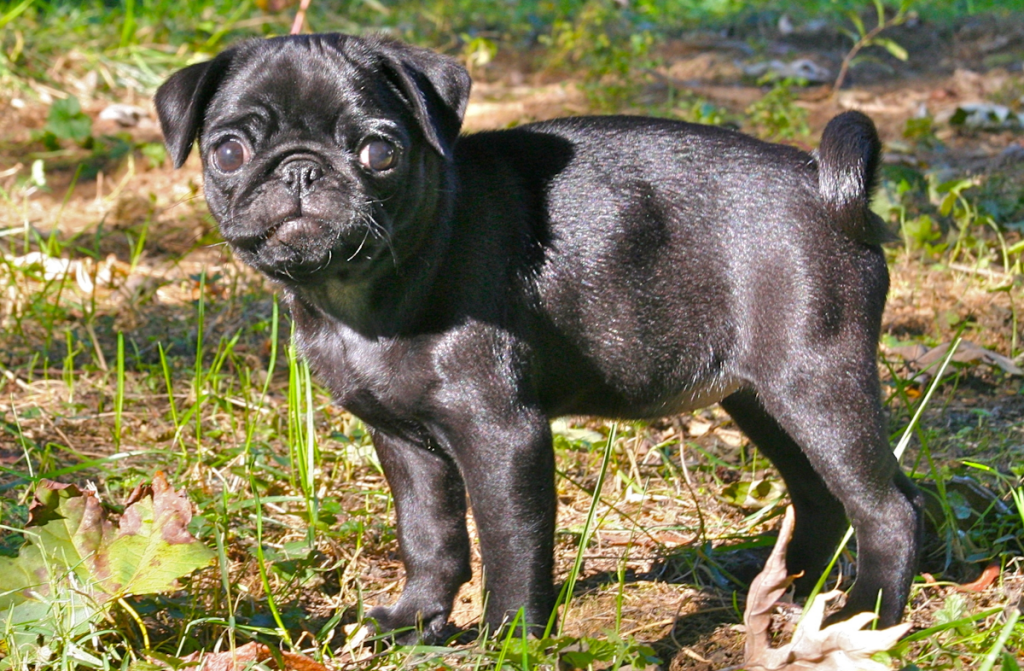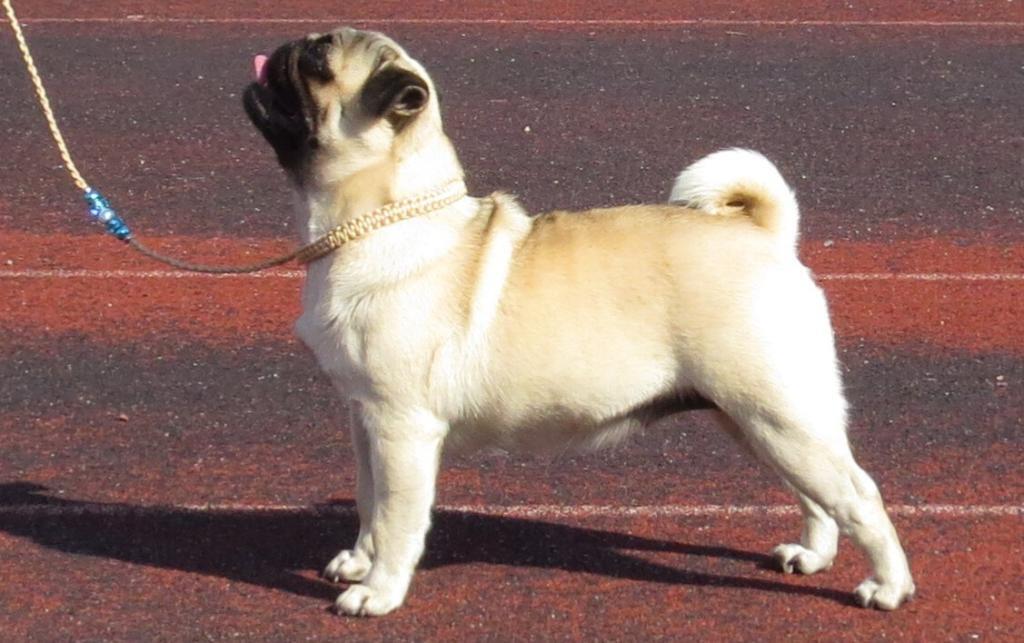Have you ever wondered what it’s like to share your home with a dog with the charisma of an ancient royal and the heart of a modern-day clown?
If you’re considering bringing a pug into your life, it’s essential to look beyond their undeniably adorable, wrinkled faces and understand what makes them tick. Known for their playful and loving temperament, pugs have charmed their way into the laps and hearts of families for centuries. But they’re not just all about warm snuggles and comedic antics; there’s a depth to this breed that often goes unnoticed.
In the following sections, you’ll uncover pugs’ multifaceted nature, from their storied history to the nuances of their care, and why their health considerations should never be taken lightly.
Stay with us as we reveal the layers that make up these delightful companions, and perhaps you’ll find that a pug’s personality is the perfect match for your home’s rhythm.
- Noise Level
- Energy
- Sociability
- Trainability
- Care
- Health
Overall
Summary
The Pug breed is moderately noisy but highly sociable with moderate energy levels. They require moderate care and have average health concerns.
Pug: Traits, Temperament, and Care Guide
With its distinctive appearance and amiable nature, the Pug requires diligent care and attention to prevent common breed-related health issues. Embodying traits such as a small, stocky frame and a wrinkled face, this breed’s temperament is friendly and affectionate, making them ideal companion animals.
Your care guide should prioritize their well-being through regular veterinary check-ups to mitigate breathing and eye problems. To maintain their health, balance is key. Exercise and mental stimulation are critical, yet due to their physical structure, activities should be moderate to prevent respiratory strain.
Obedience training and early socialization will harness their intelligent and friendly nature, while regular brushing keeps their coat healthy. An appropriate diet and your love and attention fulfills their affectionate nature, ensuring a happy, healthy Pug.
Exploring the Characteristics of the Pug
Delving into the characteristics of Pugs, it’s clear that their ancient lineage and royal Chinese heritage have shaped their unique physical and behavioral traits. With its small size and stocky build, this dog breed features distinct attributes that make Pugs both charming and practical for various owners. Known for their friendly and playful demeanor, they fit well in diverse living environments, including apartments.
| Feature | Description | Impact on Care |
|---|---|---|
| Facial Wrinkles | Deep and expressive | Requires regular cleaning to prevent skin issues |
| Curled Tail | Tightly wound spiral | Generally low maintenance but can be prone to issues |
| Short Legs | Sturdy and compact | Limits endurance; care should be taken with exercise |
| Playful Nature | Engaging and affectionate | Benefits from positive reinforcement training techniques |
Their playful nature and charming personalities endear them to people seeking companionship. However, this breed requires diligent care, mainly due to potential health issues, so positive reinforcement and regular vet check-ups are essential.
Pug: A Comprehensive Profile and Guide
You need to consider the Pug’s extensive history and its impact on their current status as a beloved companion. Assessing their unique physical traits and temperament is crucial for understanding how to care for them properly.
Determining their potential health issues ensures you’re prepared for responsible Pug ownership.
Everything You Need to Know
Pugs, with their rich history dating back to ancient China, embody a unique blend of charm and nobility that has captured the hearts of dog lovers for centuries. As you consider welcoming a Pug into your life, it’s essential to recognize their needs and traits for a harmonious companionship:
- Health Issues: Pugs, due to their short coat and facial structure, are prone to health issues like pug dog encephalitis and respiratory problems.
- Behavioral Training: Pugs are easy to train with consistent socialization, mitigating potential behavioral issues and enhancing their suitability as family pets.
- Living Conditions: Their adaptable nature makes apartment living ideal, as long as they’ve your companionship and regular exercise.
Understanding these aspects ensures your Pug thrives, providing a loving, long-term addition to your family.
Discovering the Temperament
Understanding a pug’s temperament requires recognizing that these dogs are inherently sociable creatures, eager to bond with adults and children in various living environments. Pugs love to be the focal point, displaying their playful nature and forming strong bonds with family members. They make excellent companions, particularly those who value a pet’s sense of belonging and joy in a home.
Pugs are happy to engage in activities that foster physical and mental well-being. They thrive on companionship, which is crucial for their emotional health. With their charming and distinctive personalities, Pugs are known to be highly adaptable and content in both bustling family settings and tranquil apartments. Their capacity for social interaction and adaptability makes them a beloved choice for many.

Pug: Is It a Good Fit for Families?
When considering a Pug for your family, you’ll find their affectionate nature aligns well with family dynamics.
Their adaptability to different living situations and social temperament make them a versatile choice for both active and more sedentary households.
However, it’s crucial to factor in the commitment to their health needs and regular grooming to ensure a Pug is the right fit for your family lifestyle.
Assessing Pug’s Compatibility with Families and Kids
Considering their affectionate nature, pugs often make excellent companions for families with children, offering loyalty and playfulness. As small dogs, they fit well into various living situations, including apartments. However, pugs have specific health conditions requiring attention, making it essential for families to be aware of and proactive in their care.
To ensure your dog thrives in a family environment:
- Early socialization and training classes are recommended to help pugs get along well with everyone, including kids.
- Regular exercise and diet management are key to preventing weight gain and maintaining a happy and affectionate demeanor.
- Children should always be supervised when interacting with dogs, to ensure the safety and well-being.
Pugs are a popular pet choice because they integrate seamlessly into the family unit.
Pug Adaptability Insights
Pugs’ remarkable adaptability makes them ideal companions for cozy apartment living and more spacious home environments. Their small stature means they don’t require vast spaces to feel at home, making them ideal for apartments or houses. While their moderate energy levels demand daily exercise, they’re also content with snuggle sessions on the couch. However, they shouldn’t be left alone for long periods, as they thrive on companionship and can develop separation anxiety.
Despite their easy-to-care-for nature, regular bathing and grooming are essential due to their short coats. Pugs are generally good with other pets and can adapt to a multi-animal household, fostering a sense of belonging. Remember, their adorable presence comes with health problems and loud snoring, so a systematic approach to their care is crucial.
Pug Obedience Essentials
As you prepare to train your Pug, adopting effective strategies sensitive to their nature is essential.
Studies indicate that pugs respond best to positive reinforcement, so rewards and praise should be your go-to tools for obedience training.
Consistency in your approach will help mitigate their stubborn streak and ensure a well-behaved companion.
Effective Training Strategies
To effectively train your Pug, it’s crucial to employ positive reinforcement techniques, which capitalize on their intelligence and cater to their sometimes stubborn nature. When you spend time on dog training, it’s important to note that every dog, including your Pug, requires a tailored approach. Pugs’ history as a companion toy breed means they thrive on attention and are eager to please when motivated correctly.
Here’s a systematic strategy to enhance your canine companion’s obedience:
| Age Stage | Focus Area | Training Tips |
|---|---|---|
| Puppy | Socialization | Introduce to various settings |
| Young Adult | Basic Commands | Use consistent cues |
| Adult | Mental Stimulation | Introduce puzzle toys |
| Senior | Gentle Exercise | Short walks, low-impact play |
| All Ages | Positive Reinforcement | Reward good behavior |
Integrate these practices into your routine and share your journey on social media to connect with a community that cherishes belonging.
Exercise and Grooming Needs
Maintaining a healthy lifestyle for your pug requires up to an hour of daily exercise and consistent grooming practices to control shedding and ensure overall well-being. These little dogs are relatively easy to care for, with their smooth coat only needing regular brushing to minimize shedding. Investing in quality grooming tools and a vacuum can help manage loose fur.
Spending time in interactive play or yard activities is vital for burning off energy. Moreover, their wrinkled faces demand attention; cleaning the creases prevents skin issues. Also, nail trimming regularly, along with ear cleaning and dental hygiene, are crucial for their health.

Health Considerations
As you consider a Pug for your next pet, it’s crucial to understand their common health issues and typical lifespan.
Evidence shows that regular vet check-ups and ethical breeding practices are key to mitigating the breed’s predisposition to certain ailments.
Your awareness and proactive care can significantly influence the quality and duration of your Pug’s life.
Common Health Issues and Lifespan
Pugs often face significant health challenges, including breathing difficulties and eye conditions, and generally have a lifespan that extends beyond seven years. As pets integral to your family, it’s crucial to be aware of these common health issues. According to a recent study, Pugs are expected to live 12 to 15 years.
Breathing problems, such as respiratory distress, are prevalent given their brachycephalic breed characteristics. The Pug Dog Club emphasizes that pugs are often at risk of overheating due to their compact nasal passages.
Preventive care is key to ensuring good health and longevity. Regular veterinary check-ups can help manage certain health conditions inherent in pugs. Responsible breeding practices reduce inherited health issues, while proper nutrition supports their well-being.
Is Pug the Right Dog for You?
Considering a Pug as your next canine companion requires carefully evaluating your ability to meet their needs, including regular health check-ups and a commitment to daily grooming.
As pet parents, you must assess whether you can handle potential breathing problems and eye ailments common to the breed, ensuring their overall health is maintained.
Pugs aren’t good watchdogs, but due to their adaptability, they make ideal pets for apartment or house dwellers. They generally get along well with other pets and thrive in environments where they aren’t left alone for extended periods.
If you’re new to dog ownership, a Pug’s friendly demeanor can provide peace of mind. Consider When Choosing a dog whether you can offer a nurturing space for a Pug’s friendly personality.
Alternatives for Pug: Charming and Companionable Small Toy Breeds
For those who adore the Pug’s charm and companionship, these small toy breeds offer a similar blend of cuteness and sociability.
| Similar Dogs | Short Description |
|---|---|
| French Bulldog | Known for its distinctive bat ears and playful disposition, making it a delightful companion. |
| Boston Terrier | A small breed with a tuxedo-like appearance, known for its friendly character and enthusiasm. |
| Shih Tzu | Lovable and great for cuddling, with a friendly disposition, ideal for companionship. |
| Brussels Griffon | Known for its human-like facial expressions and charming personality, perfect for families. |
| Cavalier King Charles Spaniel | Gentle nature, friendly demeanor, popular for its affectionate and adaptable character. |
Conclusion
In sum, while pugs may present a bouquet of health considerations, their affectionate nature, and adaptability make them a fine companions under vigilant care.
Their need for moderate exercise dovetails nicely with family life, and their sociability blooms with proper training.
If you’re seeking a small, engaging friend and are dedicated to their well-being, the pug could be a delightful addition to your home garden.
Just ensure to tend to their unique petals with diligence.
